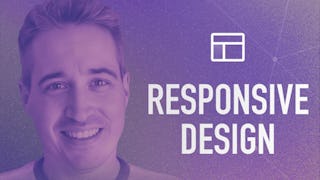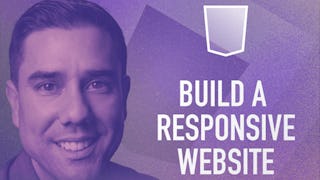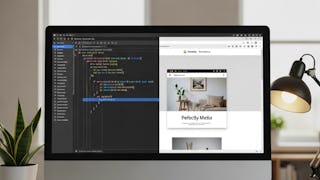In this course your web design skills go from good to great. This course is all about responsive design—creating layouts that look just as killer on a smartphone as they do on a desktop. You’ll dive into Flexbox and Grid, the CSS superheroes that make flexible, adaptive designs possible. And with media queries, you’ll fine-tune every pixel, making sure your sites look sharp no matter the screen size.

Unlock access to 10,000+ courses with Coursera Plus. Start 7-Day free trial.


Creating Responsive Websites for Any Device
This course is part of Front-End Web Development for Beginners Specialization

Instructor: University of Washington Team
Included with
Recommended experience
What you'll learn
By the end, you’ll have the skills to create a polished, multi-page website that looks professional and performs well on any screen.
Skills you'll gain
Details to know

Add to your LinkedIn profile
July 2025
12 assignments
See how employees at top companies are mastering in-demand skills

Build your subject-matter expertise
- Learn new concepts from industry experts
- Gain a foundational understanding of a subject or tool
- Develop job-relevant skills with hands-on projects
- Earn a shareable career certificate

There are 4 modules in this course
In this module, you will learn how to create responsive and visually appealing web layouts using Flexbox and CSS Grid. You’ll start by understanding the basics of Flexbox, a powerful layout tool that allows you to control the placement and alignment of elements on a web page. You’ll explore various Flexbox properties, such as flex direction, flex wrap, and justify content, to create flexible and dynamic layouts. Next, you’ll dive into HTML custom grids, learning how to structure web pages using a 12-column grid system. Finally, you’ll master CSS Grid, a modern layout system that enables you to design complex web layouts with ease. By the end of this module, you’ll be equipped with the skills to create sophisticated and responsive web designs.
What's included
4 videos6 readings2 assignments1 discussion prompt
In this module, you will enhance your web development skills by learning how to incorporate and style fonts, icons, images, gradients, and host your websites using GitHub Pages. You’ll start by exploring Font Awesome, an external library that provides a vast collection of icons that can be styled like text, adding visual appeal and functionality to your websites. Next, a refresher of CSS font styling, mastering how to control the appearance of text using properties like font-family, font-weight, font-style, and font-size, so it can be applied to Font Awesome icons. You’ll also learn how to effectively use images in HTML and CSS, including the image tag and background images, to enhance the visual content of your web pages. Additionally, you’ll discover how to create and apply CSS gradients, both linear and radial, to add depth and accents to your designs. Finally, you’ll learn how to host your websites using GitHub Pages, a free and integrated hosting solution that allows you to make your projects live on the internet. By the end of this module, you’ll be equipped with the skills to create visually engaging and professionally styled web pages and make them accessible online.
What's included
5 videos5 readings3 assignments
In this module, you will learn how to evaluate design mock-ups, understand user experience principles, create user stories, and manage the life cycle of a web project. You’ll start by exploring how to evaluate a design mock-up, breaking down the visual elements and planning the necessary HTML and CSS. Next, you’ll consider user experience (UX), focusing on the five pillars: discoverability, learnability, efficiency, consistency, and delight. You’ll learn how to create user stories, which are short, simple descriptions of features from the user’s perspective, helping you to build products that meet user needs. Finally, you’ll hear about the life cycle of a web project, from defining the purpose and user stories to organizing tasks, coding, and testing. By the end of this module, you’ll be equipped with the skills to plan, design, and execute web projects effectively, ensuring they meet user expectations and business goals.
What's included
4 videos4 readings3 assignments
In this module, you’ll learn how to make your web pages more responsive and accessible. You’ll start by understanding web accessibility and how to make your websites usable for everyone, including people with disabilities. Next, you’ll learn how to create responsive images using the srcset and sizes attributes, ensuring your images look great on any device. You’ll then explore CSS media queries, which allow you to apply different styles based on the device’s characteristics, and learn how to test these queries using Chrome DevTools. Finally, you’ll get an introduction to the Document Object Model (DOM), which is crucial for making dynamic web pages with JavaScript.
What's included
6 videos6 readings4 assignments1 peer review1 discussion prompt
Earn a career certificate
Add this credential to your LinkedIn profile, resume, or CV. Share it on social media and in your performance review.
Instructor

Offered by
Explore more from Mobile and Web Development
 Status: Free Trial
Status: Free TrialBoard Infinity
 Status: Free Trial
Status: Free TrialScrimba
 Status: Free Trial
Status: Free Trial Status: Free Trial
Status: Free Trial
Why people choose Coursera for their career





Open new doors with Coursera Plus
Unlimited access to 10,000+ world-class courses, hands-on projects, and job-ready certificate programs - all included in your subscription
Advance your career with an online degree
Earn a degree from world-class universities - 100% online
Join over 3,400 global companies that choose Coursera for Business
Upskill your employees to excel in the digital economy
Frequently asked questions
To access the course materials, assignments and to earn a Certificate, you will need to purchase the Certificate experience when you enroll in a course. You can try a Free Trial instead, or apply for Financial Aid. The course may offer 'Full Course, No Certificate' instead. This option lets you see all course materials, submit required assessments, and get a final grade. This also means that you will not be able to purchase a Certificate experience.
When you enroll in the course, you get access to all of the courses in the Specialization, and you earn a certificate when you complete the work. Your electronic Certificate will be added to your Accomplishments page - from there, you can print your Certificate or add it to your LinkedIn profile.
Yes. In select learning programs, you can apply for financial aid or a scholarship if you can’t afford the enrollment fee. If fin aid or scholarship is available for your learning program selection, you’ll find a link to apply on the description page.
More questions
Financial aid available,

